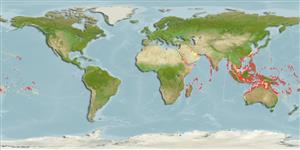Common names from other countries
Environment: milieu / climate zone / depth range / distribution range
Écologie
; profondeur 0 - 42 m (Ref. 117184). Tropical; 31°N - 32°S, 30°E - 124°W
Indo-Pacific: from East Africa to the Red Sea, (but not the Persian Gulf) to as far east as Pitcairn Islands, north to southern Japan, and south to Queensland, Australia and New Caledonia. Introduced in Hawaii and Guam.
Length at first maturity / Taille / Poids / Âge
Maturity: Lm ?, range 16 - 20 cm Max length : 45.0 cm SHL mâle / non sexé; (Ref. 95990); common length : 30.0 cm SHL mâle / non sexé; (Ref. 348)
Description synthétique
Morphologie
The species has an elongate shell with conspicuous fluted scales on its radial ridges. The valves are white and occasionally tinged with orange, and the mantle yellowish green.
Maximum depth from Ref. 87928. In eastern Polynesia, it is known to be restricted to deep water (Ref. 87928). Found in intertidal areas on corals (Ref. 75831). Abundant on outer reef slope (Ref. 2923). Also found in a lagoon (Ref. 87813), on sandy bottoms (Ref. 106695), rubble or in reef pockets (Ref. 2923). Unattached or weakly attached by byssus as an adult (Ref. 2923). Tridacnids derive their nutrition from uptake of dissolved matter through their epidermis and from their symbiotic zooanthella Symbiodinium microadriaticum (Ref. 107098).
Life cycle and mating behavior
Maturité | Reproduction | Frai | Œufs | Fécondité | Larves
Life cycle: Embryos develop into free-swimming trocophore larvae, succeeded by the bivalve veliger, resembling a miniature clam (Ref. 833).
SAUP Database. 2006. (Ref. 356)
Statut dans la liste rouge de l'IUCN (Ref. 130435)
statut CITES (Ref. 108899)
Not Evaluated
Utilisations par l'homme
Pêcheries: commercial
FAO - Aquaculture: production; | FishSource | Sea Around Us
Outils
Sources Internet
Estimates based on models
Preferred temperature
(Ref.
115969): 25 - 29.3, mean 28.4 (based on 3457 cells).
Résilience
Milieu, temps minimum de doublement de population : 1,4 à 4,4 années (K=0.08-0.23; tm=4).
Vulnérabilité
Moderate vulnerability (39 of 100).
Catégorie de prix
Unknown.
